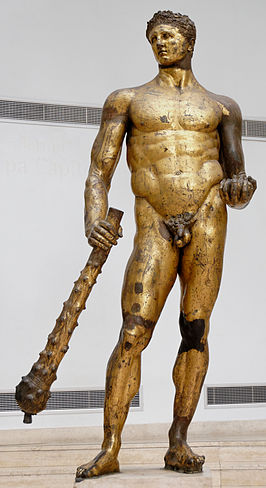Location Palazzo dei Conservatori | Subject Hercules | |
 | ||
Similar Palazzo dei Conservatori, Forum Boarium, Temple of Hercules Victor, Temple of Portunus, Maczuga Herkulesa | ||
Hercules is a gilded bronze statue discovered on the site of the Forum Boarium of ancient Rome when the remains of the temple dedicated to him were being demolished under the direction of Sixtus IV (1471–84). It was already noted in the Palazzo dei Conservatori on the Campidoglio in 1510 and it remains there today. It is likely to have been the cult image that was mentioned by Pliny in the circular Temple of Hercules Victor that stood by the ancient cattle market, which also featured an open-air altar dedicated to Hercules. The figure of Hercules bears his club at the ready, and in his left hand holds the three apples of the Hesperides. The apples identify him specifically as a Hercules of the West, where he was the victor over Geryon. In Roman versions of the narrative of the Labours of Hercules, on the Aventine hill Cacus stole some of the cattle as Heracles slept. Heracles drove his remaining cattle past a cave, where Cacus had hidden the stolen animals, and they began calling out to each other. Heracles then killed Cacus, and according to the Romans, founded an altar where the Forum Boarium, the cattle market, was later held.
The slightly over-lifesize sculpture is a Hellenistic work of the 2nd century BCE, based on the canon of proportions that had been established by Lysippos in the early 4th century: a more slender figure than the ideal of Phidias, with a proportionately smaller head. The fineness of the head is emphasised by the close-cropped hair of an athlete.
The Forum Boarium statue is one of two survivals of full-size Greek and Roman bronzes demonstrating the reaction of classicising Hellenistic and Roman sculptors to the style of Lysippus. The other comparable sculpture is the Lysippic gilded bronze that was discovered in 1864 near the Theatre of Pompey, the Hercules of the Theatre of Pompey. It had been carefully buried under protective tiles, incised FCS (fulgor conditum summanium), indicating that it had been struck by lightning and had been carefully interred on the spot. It is a Classicising Roman bronze of the early 2nd century, which adheres to the same Lysippic canon of proportions.
The figure supports himself lightly on the vertically stood club; the skin of the Nemean Lion is draped over his left forearm.
Both sculptures display the contrapposto typical of Lysippic manner, in which the figure's weight is thrown entirely on one foot. Though their musculature is exaggerated, they stand in marked contrast to the bearded, burly and perhaps more familiar Farnese Hercules.
